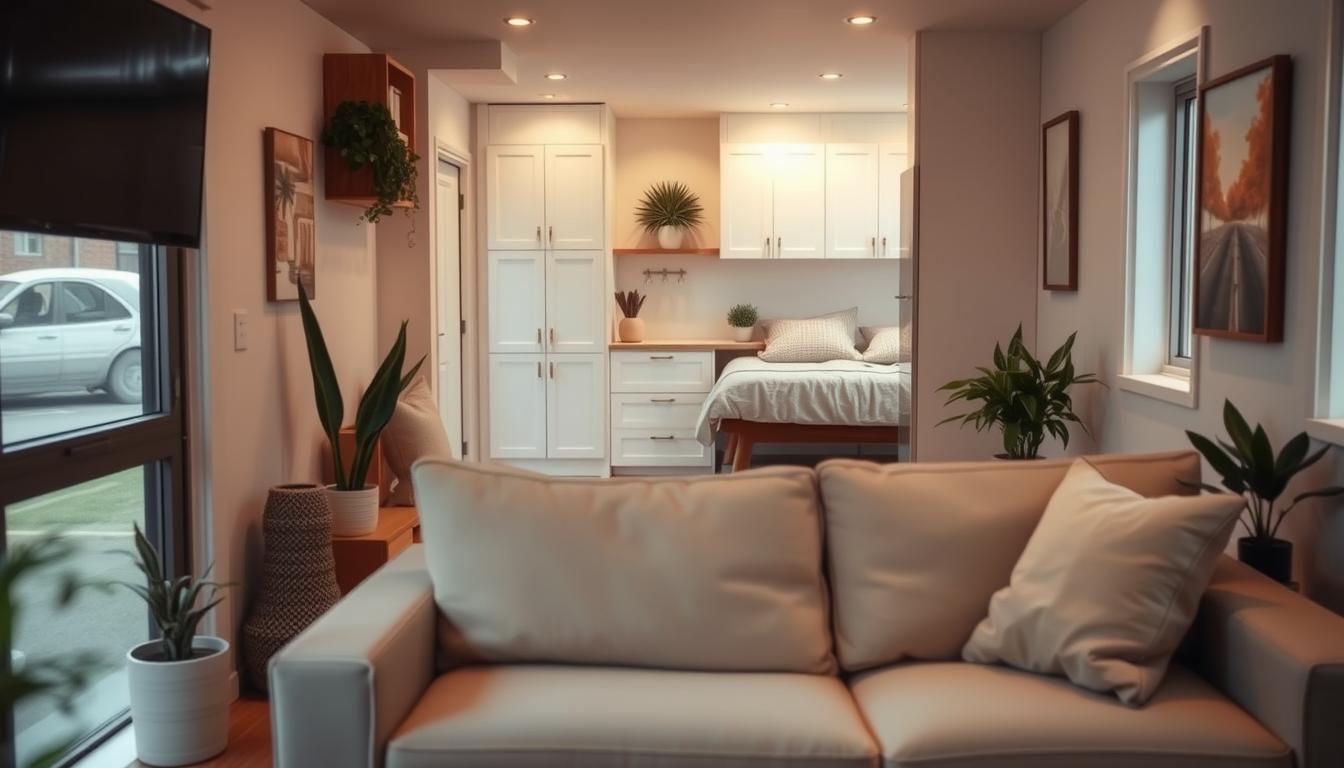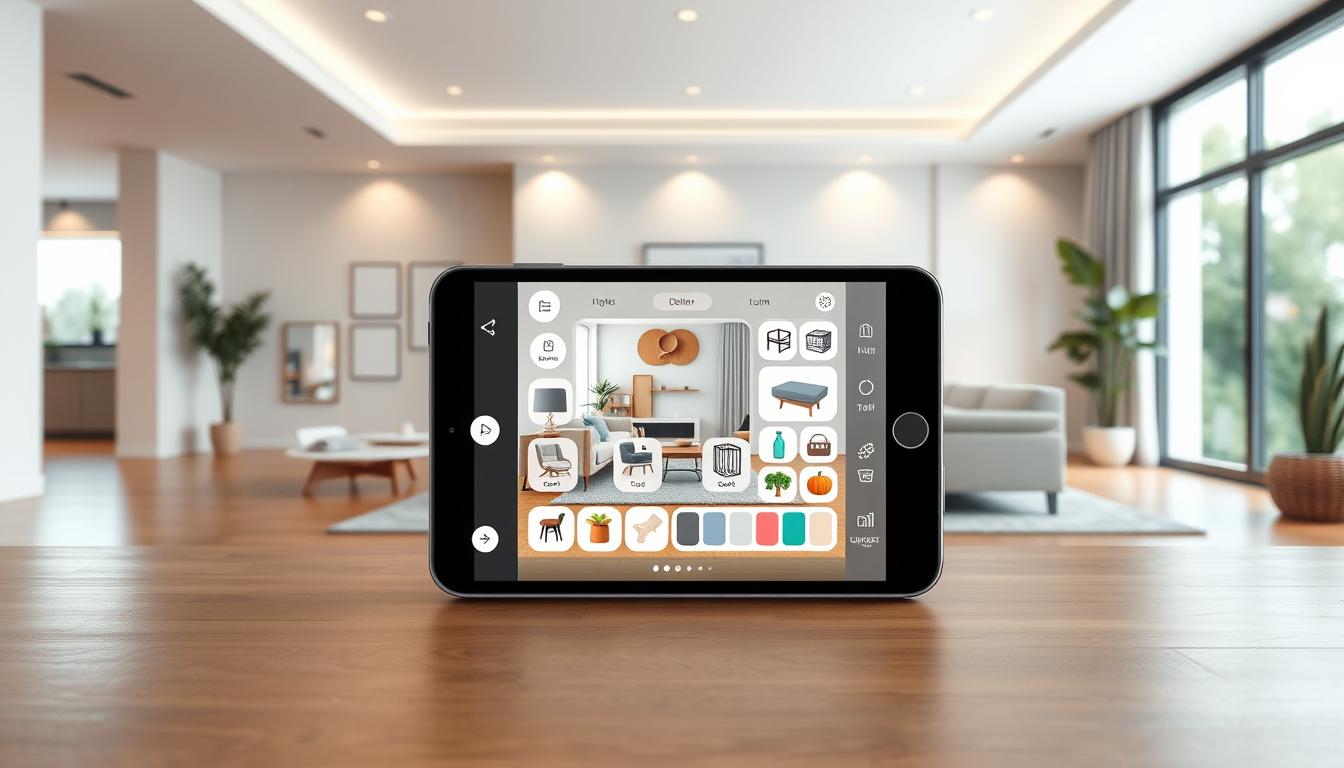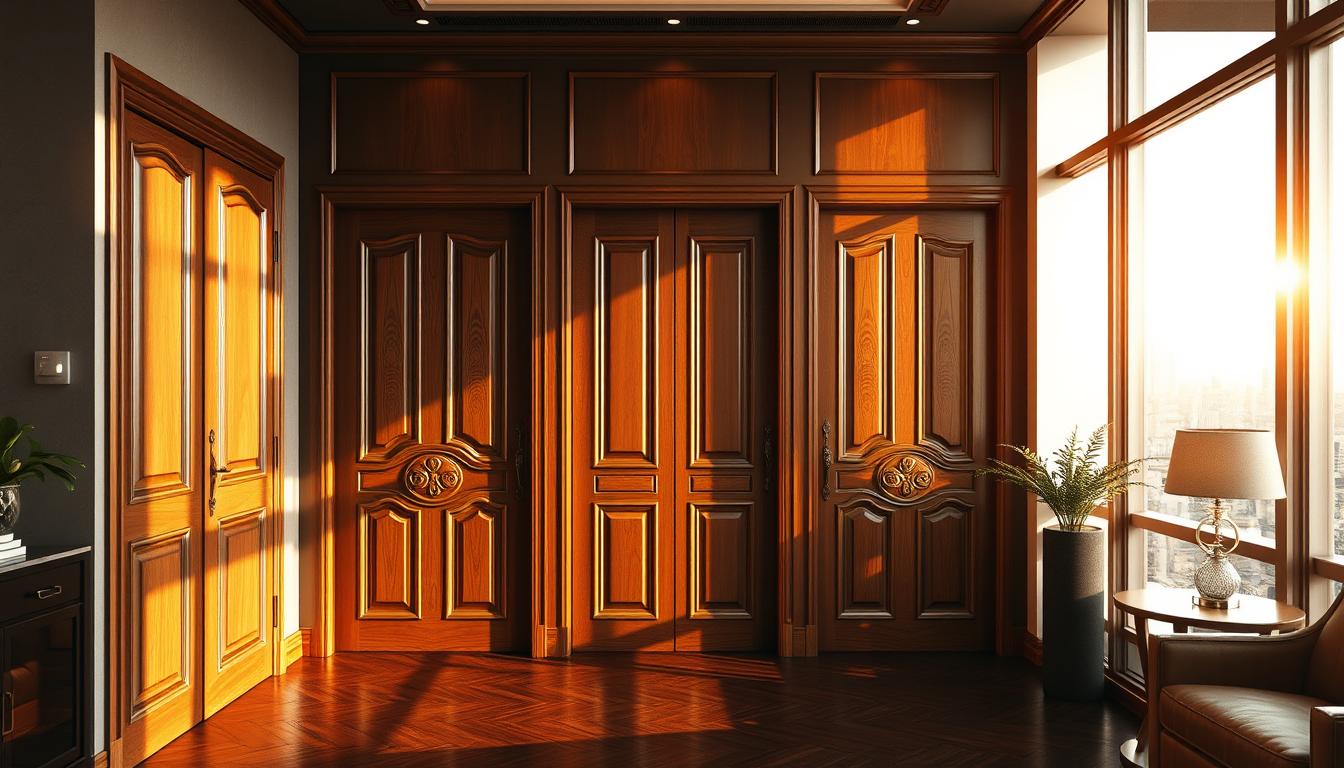Did you know the average tiny home is about 186 square feet? These small homes are full of smart design ideas. They make you feel like you have more space than you do. We’re excited to show you our top picks of tiny home interior pictures. They’ll inspire you to make your small space cozy and inviting.
Our guide is full of useful tips and beautiful pictures to help you decorate your small house. Whether you live in a tiny home or are thinking about it, we’ve got you covered. We’ll talk about design tricks, like making the most of your space and picking the right colors.
Key Takeaways
- Discover how to maximize space in your tiny home
- Learn the best color schemes for small houses
- Explore innovative storage solutions
- Get inspired by our curated tiny home interior pictures
- Find practical tips for creating a cozy and functional home
Understanding the Tiny Home Movement
The tiny home movement is all about simplicity and freedom. It’s about living without the hassle of big houses. We’ll look at what makes a home tiny, its benefits, and common features.
What Defines a Tiny Home?
A tiny home is small, usually under 400 square feet. It’s built to be efficient and functional. Often, they’re on wheels for easy moving and use eco-friendly materials.
The design focuses on simplicity and minimalism. This means no extra space is needed, just what’s essential.
Key characteristics of tiny homes include:
- Compact size
- Efficient use of space
- Sustainable materials
- Mobility (often built on wheels)
Benefits of Tiny Living
Living tiny has many perks, like being good for the planet and saving money. One big plus is the reduced environmental impact. Tiny homes use fewer resources and often have green features like solar panels.
Another big plus is the lower cost of living. They cost less to heat, cool, and maintain. Plus, they’re cheaper to buy or build than big houses.
| Benefits | Description |
|---|---|
| Environmental | Reduced resource consumption, eco-friendly features |
| Financial | Lower utility bills, reduced initial cost |
| Lifestyle | Simplified living, increased mobility |
Common Features of Tiny Homes
Tiny homes use multi-functional furniture and smart storage. You’ll find loft beds, foldable tables, and hidden spots for things. This keeps the space tidy and organized.
They also make the most of vertical space. Tall shelves and loft areas use the home’s height. This keeps the floor open and makes the space feel bigger.
“The key to a successful tiny home is not just about reducing size, but about creating a functional and comfortable living space that meets your needs.”
Designing for Small Spaces
Tiny homes need smart designs to use every inch wisely. Looking at tiny house interiors, we see that the best designs balance function and beauty.
Tips for Maximizing Space Efficiency
To make the most of tiny home space, think carefully. Use vertical space with shelves, storage, or loft beds. This saves floor space and makes the room feel bigger.
Choosing the right furniture is also key. Pick pieces that are small or do more than one thing. For example, a storage ottoman can be a seat and a place to store things, cutting down on clutter.
Choosing Multi-Functional Furniture
In DIY tiny home decorating, furniture choice is crucial. Multi-functional furniture adds charm and is practical. Think about a murphy bed or a dining table that’s also a workspace.
“The key to successful tiny home design is not just about minimizing space but maximizing the potential of that space.”
Using these ideas, you can make a space that’s both useful and cozy. The right furniture can turn a small area into a warm, personal home.
- Look for furniture with built-in storage.
- Choose items that can serve more than one purpose.
- Consider the scale of the furniture in relation to the room.
By following these tips and using tiny house interior inspiration, you can create a home that feels big, welcoming, and truly yours.
Color Schemes That Work Best
In tiny home design, color schemes are key to creating a welcoming space. The right colors can make your home feel bigger and more inviting. The wrong colors can make it feel small and cramped.
Choosing a color scheme involves balancing light and dark colors. Light colors make spaces look larger by reflecting light. Dark colors add coziness but can make rooms feel smaller if not used right.
Light vs. Dark Colors
Let’s look at the good and bad of light and dark colors in tiny homes.
- Light Colors: They make spaces look bigger, brighter, and airier. But, they can feel cold or sterile if not balanced.
- Dark Colors: They add warmth and coziness. But, they can make rooms feel smaller and darker, leading to a feeling of being trapped.
Combining light and dark colors can create a balanced and spacious feel.
Popular Color Palettes for Tiny Homes
Some color palettes are great for tiny homes. They make the space feel larger and add interest.
| Color Palette | Description | Effect on Space |
|---|---|---|
| Monochromatic | Using different shades of the same color for a cohesive look. | Makes the space feel larger and more harmonious. |
| Soft Pastels | Soft, gentle colors that add warmth without overwhelming the space. | Creates a soft, airy feel that makes the space feel larger. |
| Neutral with Bold Accents | Neutral colors as the base with bold accents for interest. | Draws the eye to specific areas, adding depth and interest. |
When picking a color palette, think about your home’s natural light and furniture colors. Try different shades and combinations to find the perfect balance.
By carefully choosing your color scheme, you can make your tiny home look and feel larger. It becomes a cozy and inviting space.
Innovative Storage Solutions
To keep your tiny home organized and spacious, smart storage solutions are key. In tiny homes, every inch counts, and clutter can make a space feel cramped.
Good storage isn’t just about hiding clutter. It’s about making your home more livable and enjoyable. With innovative storage ideas, your tiny home can feel larger than it is.
Under-Bed Storage Ideas
The area under the bed is often wasted in homes, including tiny ones. Using under-bed storage can greatly increase your space without taking up more floor area.
- Use bed risers or storage bins to make the most of the space under your bed.
- Think about installing drawers or shelves that pull out from under the bed.
- Store out-of-season clothes, bedding, or linens in under-bed containers.
Utilizing Vertical Space
Using vertical space is another smart way to store more in a tiny home. Wall-mounted shelves, storage units, and other vertical solutions help keep things organized and floors clear.
| Storage Solution | Description | Benefits |
|---|---|---|
| Wall-Mounted Shelves | Shelves attached to the wall for books, decorative items, or kitchenware. | Keeps items off the floor, adds storage without using floor space. |
| Vertical Storage Units | Tall, narrow units for clothes, cleaning supplies, or pantry items. | Uses vertical space well, keeps items organized and easy to find. |
| Hanging Organizers | Organizers for the back of a door or wall for shoes, accessories, or cleaning supplies. | Uses wasted space, keeps items off the floor and out of the way. |
By using these smart storage solutions, your tiny home can be more organized and feel spacious. For more small space interior design ideas, check out our gallery of tiny home interior pictures for inspiration.
Flooring Options for Tiny Homes
Flooring is key in tiny home interiors. It affects both style and size. Think about durability, upkeep, and looks when picking flooring.
Best Types of Flooring Materials
Many flooring materials work well in tiny homes. Hardwood flooring is loved for its classic look and toughness. It warms up the space, making it feel cozy.
Engineered hardwood is a smart pick for those on a budget. It looks like solid hardwood but is more stable.
Laminate flooring is durable and easy to care for. It’s great for tiny homes because it’s resistant to scratches and water. Luxury Vinyl Tiles (LVT) are also popular. They’re versatile, water-proof, and comfy to walk on.
How Flooring Affects Perception of Space
Flooring choice can change how a tiny home feels. Lighter floors make rooms look bigger by reflecting light. Darker floors, on the other hand, can make a space feel cozier but smaller.
The pattern and direction of flooring also matter. Planks laid parallel to long walls can make a room seem longer. Using the same flooring everywhere helps the space feel bigger and more connected.
The right flooring can make a tiny home feel bigger and more stylish. By picking the right type, color, and pattern, you can create a cozy tiny home design that’s both beautiful and practical.
Creating Cozy Living Areas
A cozy living area is key in a tiny home, blending function with warmth and character. Every detail matters in tiny homes. We’ll show you how to make your living space cozy and personal.
Let’s look at what makes a space feel inviting. In minimalist tiny house interiors, simplicity and function are key. Here are some important elements:
- Plush textiles such as throw blankets and pillows
- Comfortable seating options like sofas or armchairs
- Warm lighting that creates a cozy ambiance
Essential Elements of a Comfortable Space
Designing your tiny home’s living area needs comfort and relaxation. For a DIY tiny home decorating project, think about these:
- Choose multi-functional furniture that serves more than one purpose.
- Incorporate natural elements like plants or a vase with branches.
- Use rugs and mats to define different areas within the space.
As
“The way you furnish and decorate your tiny home can greatly impact how spacious it feels.”
This quote shows how important thoughtful design is for a spacious feel.
Choosing the Right Lighting
Lighting greatly affects your tiny home’s ambiance. For coziness, mix different lighting sources:
- Table lamps for task lighting
- String lights or fairy lights for ambiance
- Floor lamps to create a warm glow
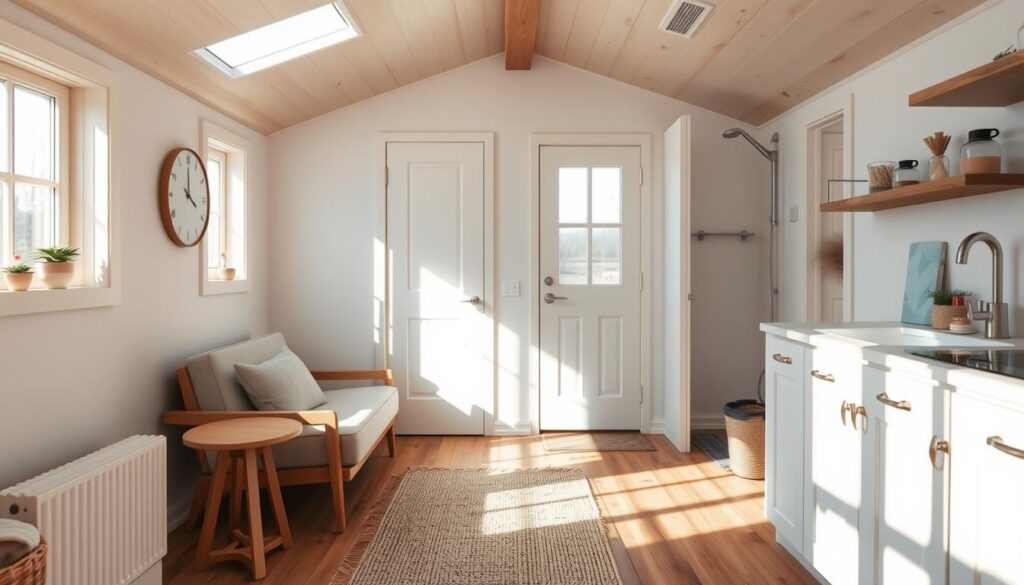
By picking the right lighting and adding comfort elements, you can make a cozy living area. It will feel spacious and welcoming. Whether you’re decorating yourself or improving your space, these tips will help you create a warm home.
The Importance of Natural Light
Using natural light well is key in tiny homes. It makes the space feel open and livable. A small, closed area can become bright and welcoming with natural light.
Incorporating Windows and Skylights
Windows and skylights are great for adding natural light to tiny homes. Placing windows to catch the sun’s rays at different times brightens the interior. Skylights bring light from above, making the space feel bigger and airier.
When picking windows and skylights, think about your tiny home’s layout. South-facing windows get more sunlight. Skylights work well in hallways or bathrooms where regular windows are hard to place.
Benefits of an Open Floor Plan
An open floor plan helps spread natural light in tiny homes. It reduces walls and partitions, creating a space that feels more open. This allows natural light to reach deeper inside.
Open floor plans do more than just let in light. They also make the space feel bigger and improve flow. With smart furniture and decor, an open plan can make your tiny home feel bigger and more welcoming.
By focusing on natural light and using design elements like windows, skylights, and open plans, you can make your tiny home brighter and more inviting. It will feel larger than it is.
Tiny Kitchen Inspirations
Creating a kitchen in a tiny home is about using space wisely and looking good. The kitchen is key in any home, and tiny homes are no different. We aim to show you tiny kitchen designs that are both efficient and stylish.
Efficient Kitchen Layouts
Layout is key in a tiny kitchen. Optimizing the work triangle — sink, stove, and fridge — is essential. Go for a galley or L-shaped layout to save space.
- Use corner spaces with carousel units or baskets.
- Pick compact appliances that meet your needs.
- Get a foldable or retractable kitchen island for more counter space.
As compact living space decoration experts, we say keep your kitchen tidy and organized. This makes it look bigger and work better.
Stylish Yet Functional Appliances
Appliances in a tiny kitchen should look good and work well. Multi-functional appliances are smart, like a microwave-toaster oven combo or an instant pot that replaces several appliances.
- Find appliances that match your kitchen’s style.
- Choose energy-efficient ones to save money.
- Compact dishwashers or hand-washing stations are good alternatives to big dishwashers.
Exploring small space interior design ideas shows that the right appliances matter a lot. They save space and add to your kitchen’s style.
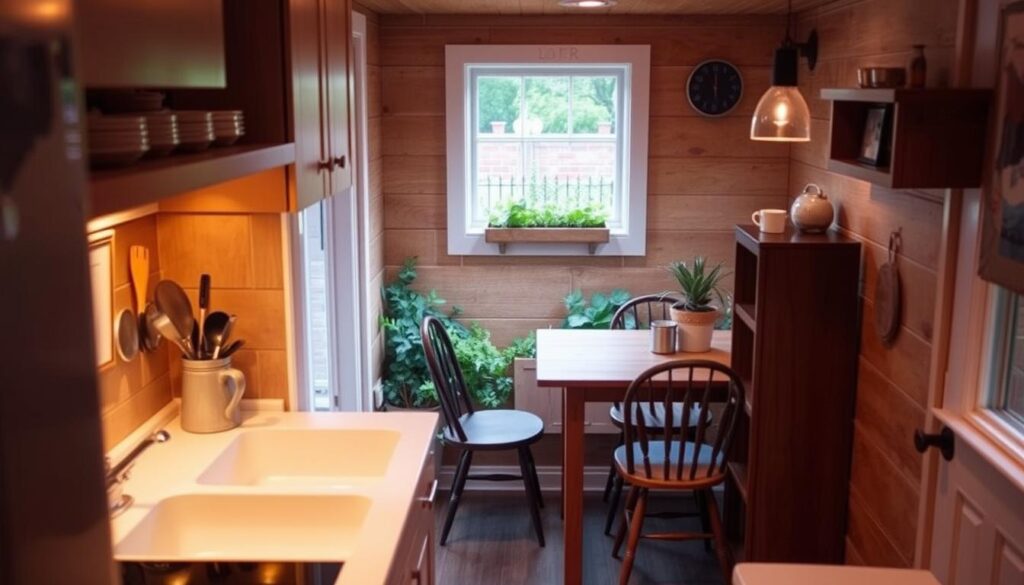
With smart layouts and the right appliances, you can make a tiny kitchen that’s both lovely and useful. We hope these ideas help you design your dream tiny home kitchen.
Bathrooms in Tiny Homes
Tiny home bathrooms are a challenge, but they can be stylish and functional. The secret is to use space wisely without sacrificing comfort or looks.
Space-Saving Bathroom Designs
Wall-mounted fixtures are a great way to save space. Wall-mounted sinks and toilets open up the area and make cleaning simpler. Choosing a shower stall over a bathtub also saves space.
Using the space above the toilet or sink with wall-mounted cabinets or shelves adds storage without taking up floor space. A compact vanity or pedestal sink keeps the area feeling open.
Unique Fixtures for Small Bathrooms
In tiny bathrooms, picking the right fixtures is key. Compact toilets save space and are good for the planet. Corner sinks use wasted corner space well.
For lighting, LED strip lighting under cabinets or around mirrors adds warmth without using much space. A folding or retractable drying rack is also handy, saving space when not in use.
With these space-saving designs and unique fixtures, your tiny home bathroom can be both functional and stylish. It will add to the cozy tiny home design, making your home feel welcoming and spacious.
Personalizing Your Tiny Home
Personalizing your tiny home means making it reflect your personality and style. It’s the small details that really make a difference. Adding elements that mean something to you can make your space cozy and inviting.
Incorporating Personal Touches
Adding personal touches is a simple way to make your tiny home unique. This can include family photos, heirlooms, or mementos that hold special meaning. For example, vintage items or antique pieces can add character to your space.
Think about using decorative items that show your hobbies or interests. If you love reading, a bookshelf with your favorite books is a great choice. Art lovers can hang pieces that speak to them, making their space feel more personal.
Choosing Artwork and Decor
Choosing the right artwork and decor is key for your tiny home. Pick pieces that are not just beautiful but also meaningful. For a minimalist look, choose simple yet striking items that don’t clutter the space.
Mixing different textures and materials can add interest. For example, combining smooth and rough textures creates a nice contrast. Adding natural elements like plants or a vase with branches can also warm up your space.
| Decor Idea | Description | Benefit |
|---|---|---|
| Family Photos | Displaying cherished memories | Creates a sense of warmth and belonging |
| Artwork | Reflects personal style and taste | Adds character and personality to the space |
| Natural Elements | Bringing the outdoors in | Enhances the aesthetic and creates a calming atmosphere |
Real Tiny Home Interior Pictures
We have a collection of real tiny home interior pictures to inspire you. These show beautiful and functional designs that prove tiny home living is great. You’ll find DIY decorating ideas to make your space unique and cozy.
Featured Designs
Our featured designs include cozy lofts and efficient kitchens. They highlight what makes tiny homes special. You’ll see clever storage and stylish decor in every corner.
Inspiring Spaces
We love sharing inspiring spaces that show what tiny home living can be. Whether you need ideas for space or just want to be inspired, our tiny homes will delight you. Get ready to be inspired and start planning your own DIY tiny home project.

